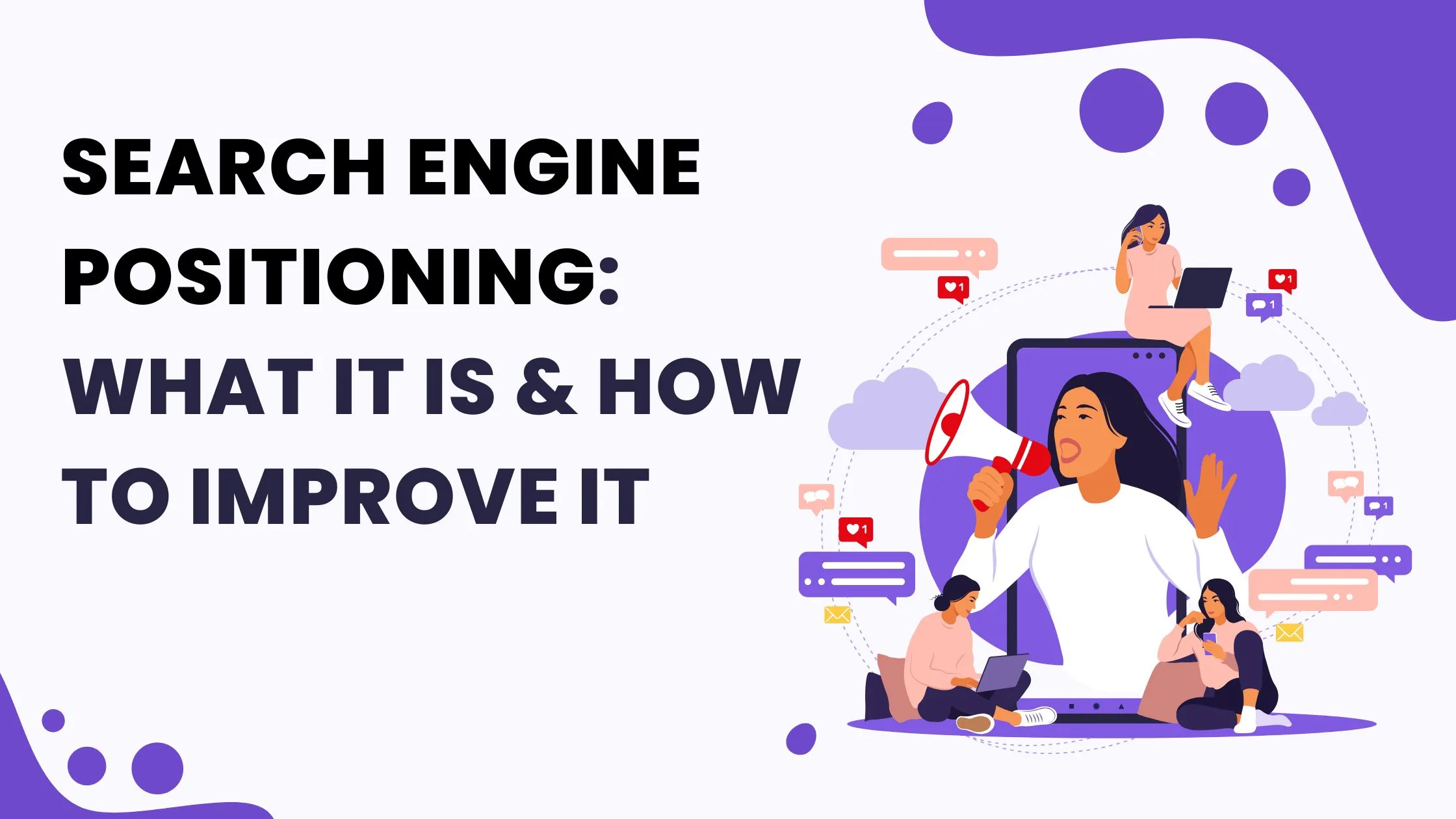Hello Folks!!!
You’ve invested time and effort into building your website and perfecting your content, only to see it sitting on Google’s second page.
It can feel discouraging—I know the feeling all too well! But being stuck on the second page doesn’t mean you have to remain there. Search engine positioning is the process of fine-tuning your pages so they can climb higher in the rankings and reach those top spots.
Looking to boost your pages through search engine positioning? In this guide, you’ll learn what search engine positioning means, why it matters, and how to increase your chances of landing in the prime spots on search results.
Key Takeaways
- Search engine positioning involves making adjustments to individual pages on your website to help them rank higher for chosen search terms.
- It differs from search engine optimization (SEO) since positioning focuses on fewer pages and often delivers quicker results.
- Enhancing rankings through search engine positioning can raise your click-through rate, which leads to more organic traffic and conversions.
- Ways to improve positioning include updating page content, checking internal linking, refining metadata, and building backlinks through targeted outreach.
- Monitoring your rankings is crucial to determine whether further adjustments are needed.
What Is Search Engine Positioning?
Search engine positioning refers to optimizing selected pages on your site so they appear higher in search engine results.
For instance, if a SERP analysis shows one of your pages sitting at position eleven—just outside page one—a few smart changes can help push it into the top ten.
Beyond improving visibility, search engine positioning can also help capture more space in the search results, such as featured snippets or AI-driven overviews, boosting the likelihood of attracting clicks to your site.
Why It Matters
Climbing higher in search engine results can have a direct impact on your business.
Strong search engine positioning helps boost your click-through rate (CTR), which leads to increased organic traffic and, ultimately, more conversions.
Research shows that the first three results on Google collectively achieve a CTR of 18.21 percent, with the percentage dropping as you move further down the rankings.
In addition to driving more traffic and strengthening brand visibility, search engine positioning offers several other advantages:
- It improves your chances of being highlighted in featured snippets or included in AI Overviews.
- Ranking at the top signals to potential customers that your business is credible and trustworthy.
- Regularly updating content delivers extra value to readers, positioning your brand as a knowledgeable authority in your field.
Search Engine Positioning vs. SEO
You may wonder if search engine positioning is simply another name for SEO, since both aim to improve Google rankings. While related, they are not identical strategies.
Here’s how they differ:
- SEO focuses on optimizing the entire website, while search engine positioning targets specific pages or a select group of pages for improved rankings.
- SEO is a long-term approach, often requiring three to six months for significant results across your site.
- Search engine positioning, on the other hand, is shorter-term and may produce quicker improvements since the focus is on fewer pages.
Tips to Improve Your Search Engine Positioning
1. Identify Target Pages
The first step is deciding which pages to optimize for the biggest impact.
Focus on:
- Pages sitting on the second page of search results, which you can nudge onto the first page.
- Pages already on the first page, but close to breaking into the top three positions.
You should also consider the type of content you want to improve. Prioritize evergreen content that will stay relevant over time or key product/service pages that directly drive conversions.
To figure out which pages and keywords to focus on, you can use SEO tools. For instance:
- Google Search Console: Head to Search Results, switch to Pages, and review the average ranking position of each page.
- Ubersuggest’s Rank Tracking Report: See the keywords you currently rank for, their competitiveness, and how rankings change over time.
2. Update and Improve Your Existing Content
Once you’ve selected the page or pages to work on, the next step is to give the content a refresh.
With Google’s Helpful Content Update (2022), the search engine places higher value on content that is reliable, relevant, and genuinely useful. Refreshing your material not only helps improve rankings but also provides a better experience for your audience.
An added benefit is that when you update content and revise the publish date, the new date appears in search results—making your page look more current and appealing to users.
When updating content, be sure to:
- Review all external links and replace or remove any that are broken or outdated.
- Revise information that’s no longer accurate or useful.
- Break up long text with headings, bullet points, and shorter paragraphs for easier reading.
- Target fresh keywords that are now relevant.
- Correct any grammar or spelling errors.
- Include updated visuals, such as images or videos, and ensure alt text is optimized.
A smart approach is to study the top-ranking results for your target keyword. Look at who their content serves, its length, and the questions it addresses—then aim to create something even better.
3. Strengthen Your Internal Linking Strategy
A well-planned internal linking structure offers multiple advantages:
- It guides readers to additional resources, keeping them engaged on your site longer.
- It helps search engines crawl and index your site more efficiently.
- It passes link equity (often called “link juice”) to other pages, improving their chances of ranking higher.
To maximize the impact of internal links on your search engine positioning:
- Choose destination pages wisely—link to the ones that will gain the most from extra authority.
- Use descriptive, keyword-rich anchor text instead of generic phrases like “click here.”
- Avoid overloading a page with too many links, as this can weaken their value.
- Revisit older content and add new, relevant internal links where appropriate.
4. Boost Your Organic CTR
Improving search engine positioning isn’t limited to on-page changes—it also involves optimizing how your pages appear in search results.
Your title tag and meta description are the first things users see on Google. Well-crafted, relevant titles and descriptions encourage clicks, raise your CTR, and signal to search engines that your content deserves better rankings.
To improve CTR and strengthen positioning:
- Write unique titles and meta descriptions for every page.
- Keep them concise so they display fully in search results.
- Incorporate keywords naturally, without forcing them in.
- Add a compelling call-to-action that motivates users to visit your site.
5. Refine Your Backlink Approach
Understanding Google’s ranking factors is vital when optimizing your web pages. Backlinks remain one of the most powerful signals influencing search rankings.
Links from authoritative, relevant websites serve as endorsements for your content, strongly impacting its placement in search results.
There are two main methods to earn backlinks:
- Publish exceptional content that naturally attracts links.
- Conduct strategic outreach to encourage other sites to link to your pages.
A practical way to approach outreach is by using a backlink analysis tool to identify where your competitors are getting their links. You can then connect with those same sites and request them to consider linking to your content.
Always prioritize quality over quantity—one valuable backlink will boost rankings more effectively than many low-quality ones.
6. Track Your Progress
After implementing these strategies, it’s important to measure how your rankings respond to the changes.
As mentioned earlier, tools like Google Search Console and Ubersuggest’s Rank Tracking report are excellent starting points. Platforms such as Semrush and Ahrefs also provide robust page and keyword monitoring features.
If your rankings don’t improve, consider refining your approach. Reevaluate your target audience and explore new ways to create content that connects with them and solves their challenges.
Don’t Overlook Your Technical SEO Essentials
Search engine positioning is powerful, but it works best when paired with technical SEO practices.
Your page may contain valuable, keyword-rich, and informative content. Yet, if the site isn’t mobile-friendly, loads slowly, or fails Core Web Vitals, it will struggle to rank.
Always consider the user experience your website delivers. Technical SEO ensures your visitors enjoy seamless navigation and performance.
This approach not only helps individual pages rank higher but also strengthens the overall visibility of your entire site in search results.
FAQs
What is search engine positioning?
Search engine positioning focuses on optimizing a single web page to achieve higher rankings in search engine results.
Why is search engine positioning important?
It helps drive more targeted visitors to your website. Strong positioning also improves chances of appearing in featured snippets or AI-generated summaries.
How can you measure search engine positioning?
You can track it using tools like Google Search Console, Semrush, Ahrefs, or Ubersuggest Rank Tracking.
What is technical SEO?
Technical SEO involves optimizing the backend of your site, including site speed, mobile responsiveness, indexing, crawlability, and Core Web Vitals.
How does technical SEO affect rankings?
Search engines prioritize sites that load quickly, are secure, mobile-friendly, and easy to navigate. Poor technical performance can prevent high rankings.
What are Core Web Vitals?
Core Web Vitals are Google’s key performance metrics that measure loading speed, interactivity, and visual stability on a web page.
Can technical SEO improve the whole website?
Yes. Enhancing technical SEO benefits all pages on your site, leading to better user experience and stronger overall rankings.
How often should I check my technical SEO?
Regular audits are essential. Reviewing technical SEO every 3–6 months ensures your site stays optimized and performs well with new Google updates.




